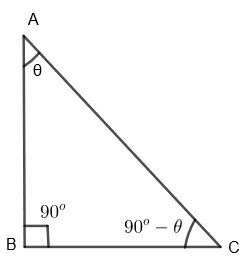
In a \[\Delta ABC,\text{ }{{\cos }^{2}}A+{{\cos }^{2}}B+{{\cos }^{2}}C=1\]. Prove that the triangle is right-angled.
Answer
607.5k+ views
Hint: Assume a right-angled triangle ABC. Take the cos of each angle of \[\Delta ABC\] and square them separately. Add them to get \[{{\cos }^{2}}A+{{\cos }^{2}}B+{{\cos }^{2}}C=1\]. Since we are already given this result, this means that our assumption is correct. Hence solve the question by this approach.
Complete step-by-step answer:
Here we are given that in \[\Delta ABC,\text{ }{{\cos }^{2}}A+{{\cos }^{2}}B+{{\cos }^{2}}C=1\]. We have to prove that triangle ABC is a right-angled triangle.
Let us assume a \[\Delta ABC\] such that it is right-angled at B.

Let us take \[\angle A=\theta \], we know that in any triangle, the sum of 3 angles is \[{{180}^{o}}\]. So, we get,
\[\angle A+\angle B+\angle C={{180}^{o}}\]
By substituting the value of \[\angle A=\theta \] and \[\angle B={{90}^{o}}\], we get,
\[\theta +{{90}^{o}}+\angle C={{180}^{o}}\]
$\Rightarrow$ \[\angle C={{180}^{o}}-\theta -{{90}^{o}}\]
$\Rightarrow$ \[\angle C={{90}^{o}}-\theta \]
Now, we know that \[\angle A=\theta \]. By taking cos on both sides, of the above equation, we get,
\[\cos \left( A \right)=\cos \theta \]
By squaring both sides of the above equation, we get
$\Rightarrow$ \[{{\cos }^{2}}\left( A \right)={{\cos }^{2}}\theta ....\left( i \right)\]
Now, we also know that \[\angle B={{90}^{o}}\].
By taking cos on both sides of the above equation, we get
$\Rightarrow$ \[\cos B=\cos {{90}^{o}}\]
By squaring both sides of the above equation, we get,
$\Rightarrow$ \[{{\cos }^{2}}B={{\cos }^{2}}{{90}^{o}}\]
We know that \[\cos {{90}^{o}}=0\], so we get,
$\Rightarrow$ \[{{\cos }^{2}}B=0....\left( ii \right)\]
Now, we have found that \[\angle C=\left( {{90}^{o}}-\theta \right)\]
By taking cos on both sides of the above equation, we get,
$\Rightarrow$ \[\cos C=\cos \left( 90-\theta \right)\]
By squaring both sides of the above equation, we get,
$\Rightarrow$ \[{{\cos }^{2}}C={{\cos }^{2}}\left( 90-\theta \right)\]
We know that \[\cos \left( 90-\theta \right)=\sin \theta \]. So, we get,
$\Rightarrow$ \[{{\cos }^{2}}C={{\sin }^{2}}\theta ....\left( iii \right)\]
By adding equation (i), (ii) and (iii), we get,
$\Rightarrow$ \[{{\cos }^{2}}A+{{\cos }^{2}}B+{{\cos }^{2}}C={{\cos }^{2}}\theta +0+{{\sin }^{2}}\theta \]
$\Rightarrow$ \[{{\cos }^{2}}A+{{\cos }^{2}}B+{{\cos }^{2}}C={{\cos }^{2}}\theta +{{\sin }^{2}}\theta \]
We know that \[{{\cos }^{2}}\theta +{{\sin }^{2}}\theta =1\]. So, we get,
$\Rightarrow$ \[{{\cos }^{2}}A+{{\cos }^{2}}B+{{\cos }^{2}}C=1\]
This result is the same as what is given in the question and this is true only for our assumption. That means our assumption was correct. Therefore, we get \[\Delta ABC\] as a right-angled triangle.
Hence proved.
Note: In these types of questions, students are advised to go in the reverse direction. That means, they must assume the desired result and solve accordingly to prove the result already given in the question. If they can finally get the result already given in the question that means their assumption was correct.
Complete step-by-step answer:
Here we are given that in \[\Delta ABC,\text{ }{{\cos }^{2}}A+{{\cos }^{2}}B+{{\cos }^{2}}C=1\]. We have to prove that triangle ABC is a right-angled triangle.
Let us assume a \[\Delta ABC\] such that it is right-angled at B.

Let us take \[\angle A=\theta \], we know that in any triangle, the sum of 3 angles is \[{{180}^{o}}\]. So, we get,
\[\angle A+\angle B+\angle C={{180}^{o}}\]
By substituting the value of \[\angle A=\theta \] and \[\angle B={{90}^{o}}\], we get,
\[\theta +{{90}^{o}}+\angle C={{180}^{o}}\]
$\Rightarrow$ \[\angle C={{180}^{o}}-\theta -{{90}^{o}}\]
$\Rightarrow$ \[\angle C={{90}^{o}}-\theta \]
Now, we know that \[\angle A=\theta \]. By taking cos on both sides, of the above equation, we get,
\[\cos \left( A \right)=\cos \theta \]
By squaring both sides of the above equation, we get
$\Rightarrow$ \[{{\cos }^{2}}\left( A \right)={{\cos }^{2}}\theta ....\left( i \right)\]
Now, we also know that \[\angle B={{90}^{o}}\].
By taking cos on both sides of the above equation, we get
$\Rightarrow$ \[\cos B=\cos {{90}^{o}}\]
By squaring both sides of the above equation, we get,
$\Rightarrow$ \[{{\cos }^{2}}B={{\cos }^{2}}{{90}^{o}}\]
We know that \[\cos {{90}^{o}}=0\], so we get,
$\Rightarrow$ \[{{\cos }^{2}}B=0....\left( ii \right)\]
Now, we have found that \[\angle C=\left( {{90}^{o}}-\theta \right)\]
By taking cos on both sides of the above equation, we get,
$\Rightarrow$ \[\cos C=\cos \left( 90-\theta \right)\]
By squaring both sides of the above equation, we get,
$\Rightarrow$ \[{{\cos }^{2}}C={{\cos }^{2}}\left( 90-\theta \right)\]
We know that \[\cos \left( 90-\theta \right)=\sin \theta \]. So, we get,
$\Rightarrow$ \[{{\cos }^{2}}C={{\sin }^{2}}\theta ....\left( iii \right)\]
By adding equation (i), (ii) and (iii), we get,
$\Rightarrow$ \[{{\cos }^{2}}A+{{\cos }^{2}}B+{{\cos }^{2}}C={{\cos }^{2}}\theta +0+{{\sin }^{2}}\theta \]
$\Rightarrow$ \[{{\cos }^{2}}A+{{\cos }^{2}}B+{{\cos }^{2}}C={{\cos }^{2}}\theta +{{\sin }^{2}}\theta \]
We know that \[{{\cos }^{2}}\theta +{{\sin }^{2}}\theta =1\]. So, we get,
$\Rightarrow$ \[{{\cos }^{2}}A+{{\cos }^{2}}B+{{\cos }^{2}}C=1\]
This result is the same as what is given in the question and this is true only for our assumption. That means our assumption was correct. Therefore, we get \[\Delta ABC\] as a right-angled triangle.
Hence proved.
Note: In these types of questions, students are advised to go in the reverse direction. That means, they must assume the desired result and solve accordingly to prove the result already given in the question. If they can finally get the result already given in the question that means their assumption was correct.
Recently Updated Pages
Master Class 10 General Knowledge: Engaging Questions & Answers for Success

Master Class 10 Science: Engaging Questions & Answers for Success

Master Class 10 Social Science: Engaging Questions & Answers for Success

Master Class 10 Maths: Engaging Questions & Answers for Success

Master Class 10 English: Engaging Questions & Answers for Success

Master Class 10 Computer Science: Engaging Questions & Answers for Success

Trending doubts
The shortest day of the year in India

Why is there a time difference of about 5 hours between class 10 social science CBSE

Write a letter to the principal requesting him to grant class 10 english CBSE

What is the median of the first 10 natural numbers class 10 maths CBSE

The Equation xxx + 2 is Satisfied when x is Equal to Class 10 Maths

State and prove converse of BPT Basic Proportionality class 10 maths CBSE




